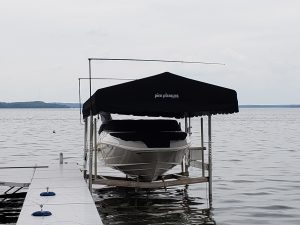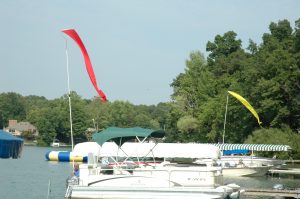Look Out Below—Searching for Solutions To Keep Nuisance Birds Away
Published on May 1, 2020Seeing a hawk soaring, a bufflehead duck bobbing, or a blue heron wading are some of the things that make time at a marina enjoyable. Seeing what birds leave behind or having them take up home on your docks can erase that joy. From plastic owls to marina dogs, marina operators have tried many solutions to rid the docks of birds and droppings with minimal success, but some products are showing promise.
Birds on the docks can create several issues. First and foremost are the bird droppings. Whether the birds are flying, nesting or lounging, they can leave a mess that is unsightly, smelly and difficult to clean. The waste is acidic making it capable of damaging everything from boat covers to outboard engines. Beyond that, bird droppings can carry transmittable diseases such as ecoli or salmonella.
The second issue comes from birds that build nests on or under canopies and covered slips. Bird poop is now mixed with feathers and nest materials, the baby birds can get noisy, and the adults have been known to fly a bit too close to people.
Finally, having a gaggle of geese take up residence on a dock combines noise and mess, but also can be quite an irritant to marina dogs.
What is a marina operator to do to keep the nuisance birds away? Reflective tape wrapped on rails, a bunch of plastic owls, aluminum pie plates strung around the dock or spikes on railings don’t help the marina’s image. Newer noise devices are another option that emit pre-recorded distress and predator calls to intimidate birds, but the constant din might also intimidate staff and customers.
Before Birds Arrive
Possibly the biggest challenge with finding a solution is that bird control measures should be installed before the pest birds arrive. For marinas with year-round birds that simply isn’t an option and for seasonal marinas, when spring arrives they are intent on launching and not thinking about what birds might soon be arriving. Once birds take up residence, they are increasingly difficult to get rid of.
Ray Fernandez who runs Bridge Marina in New Jersey is gull free on his docks, he believes, because crows have taken up residence in the trees surrounding the facility. Gulls and crows apparently don’t mix. However, when he tried this theory at his other marina on the coast, placing plastic crows out to ward off gulls, it only worked temporarily. Eventually, he found a gull perched on the plastic crow.
Rick Chapman general manager of Sunnyside Marina in Minnesota has to deal with two specific birds, gulls and sparrows. “We have seagulls that pass through in the spring and fall. Two years ago, there was some kind of fish kill that caused them to hang out for a few extra weeks. The outside face docks were covered in inches of poop. Our second bird issue is ongoing throughout the summer. Sparrows like to nest in the canopies of our slip covers. Besides being messy, they also get very aggressive when babies have hatched in their nests. Boaters have to avoid dive bombing sparrows to get to their boats,” Chapman said. His boaters have tried all kinds of things from wooden owls to shiny spinners, but nothing seems to deter the birds.
Matt Frenkey, founder of H2Owners, along with some clever friends, took

matters into his own hands. “We’ve lived on the water and so we’re all geared towards that life and particular problems that you have to live with on the water. Birds and their dropping are one of those things,” he said.
Frenkey’s main issue was birds lounging and leaving their mess on the canopies of boatlifts—unsightly, smelly and tough to remove. He developed FlyBye. Using monofilament fishing line as the primary deterrent, he created a bracket and arm system that allows users to string the line over and above the canopy. “I’ve done so much reading on this and never found a definitive answer on why fishing line is so effective but birds are much more aware of it and avoid it. Maybe they sense entanglement,” Frenkey said. He said the line is so effective it is used by the Wisconsin Department of Natural Resources to keep birds away from their fish hatcheries, and he’s seen the lines strung over numerous swimming pools in Florida.
Frenkey developed FlyBye with input from boatlift manufacturers. “They’d seen every product and knew the complaints. Installation and maintenance were the big issues,” he said. Frenkey began development of his product in 2018, testing it locally in his home state of Wisconsin. He listened to the complaints and suggestions of the users and refined the FlyBye in 2019. He made a few more modifications, before releasing it again in 2020. With three years of testing, he knew that high winds were the predominant problem, so he developed a system that would bend or, at the most extreme go out of alignment, but it didn’t break.
Frenkey’s main product mounts to the boatlift and/or canopy, but he also has a version that mounts on poles that are located on the docks. This solution came from his desire to find a pole that would hold the string lights he wanted to install on his personal dock. The fiberglass pole with an aluminum mounting system turned out to also be a viable option for stringing fishing line across the docks.
While researching bird deterrents and talking to experts, Frenkey was told that a compound, which is derivative of concord grapes, has shown great promise in scaring away many types of birds. He said it smells bad to the birds so they leave. The problem is that the product is a liquid, and water will wash it off, so it is not ideal for docks. However, it might be a solid solution for roosting areas that are often under cover.
Working in bird poop requires a sense of humor, which Frenkey captured in t-shirts he sells for FlyBye that read, “Teaching birds to poop at the neighbors since 2017.”
Scaring Pests
Another company that works in bird scare tactics is Consort Display Group that created the Dori Pole. According to Steffan Phillippo, marketing director for the company, the Dori Pole was originally designed as an outdoor event promotional piece, but someone saw it and said it’d be a cool thing to have on their dock. Scaring away birds was a bonus.

The fiberglass pole has either a 8-foot or 14-foot nylon pennant on the end of a swiveling yoke so the wind causes it to flutter. The movement and the shadows created scare the birds away. Because it is very light weight, the slightest breeze causes it to move. While the pennant is a lightweight material, it stands up in winds up to 40 mph, and Phillippo said the replacement requests are for fading and not wind damage.
An advantage of the Dori Pole is that it’s also an attractive piece to have on a dock. “Once its seen, others take notice and order it. It works so well, but looks good,” Phillippo said.
The research and inventions for deterring birds is ongoing. Frenkey’s company is working on other solutions including one he hopes will keep ducks and geese from making docks their homes. The challenge will always be that one solution will not work for every type of bird and birds don’t believe in segregation.
| Categories | |
| Tags |





